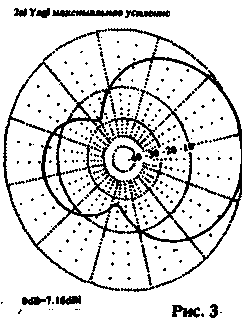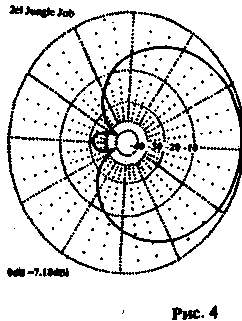
|
|
ENCYCLOPEDIA OF RADIO ELECTRONICS AND ELECTRICAL ENGINEERING JUNGLE JOB, Or new technical principles for the design of compact beams. Encyclopedia of radio electronics and electrical engineering
Encyclopedia of radio electronics and electrical engineering / HF antennas At the dawn of the development of radio communications, it was believed that antennas must be large in order for the signal to be strong. This assumption was correct, because. very low frequencies were used in that era. Later it was discovered that if 2 antennas are placed at a distance of half a wave from each other and powered in phase, then the signal will be amplified in some directions, as if the transmitter power was doubled. With three antennas, the radiation power tripled, and so on. In general, we call this the gain of the antenna system. Unfortunately, this forced the antennas to be placed in a chain one after the other, and 10 dipoles placed at a distance of half a wave from each other stretched out to a distance of S wavelengths! Antennas of this type are known as Systemes Addittoanels and are used in HF broadcasting. John Kraus W8JK was the first to test a system of 2 dipoles, but fed in counterfail. Most of the experts of that time considered this a waste of time, because. the radiation of the vibrators compensate each other. The transmitter power was fixed in several sectors, and Kraus found effective radiation in two relatively narrow sectors, but with high energy in an unexpected axis. The gain was almost 4 with only 2 dipoles, while the gain of XNUMX dipoles in the addroonnel ant is only XNUMX. The W8JK was probably the first "super-gain" antenna. It was later shown mathematically that with three elements in this arrangement one could achieve gain not 3, as in the case of ant addltonnel, but closer to nine. The evolution of the W8JK concepts has led to a range of "super gain" antennas. In this series, Yagl is the most famous. VHF often uses one powered element, several passive directors and one or two reflectors. The total boom length reaches several wavelengths. Each element is located at a distance of 0,2 ... 0,3 wavelengths from the other, in this case there is a lesser effect on the antenna bandwidth, input impedance and efficiency. In most cases, a compromise is used with the arrangement of elements at a distance less than optimal (up to 0,1 wavelength). My experiments were based on using a wire "V" reflector instead of the usual aluminum tubes. A reflector made of wire not only reduces the weight, wind resistance, and cost of the antenna, but also allows for a lighter boom. Figure 1 shows a general view of this design. With this design, the space required for antenna rotation is significantly reduced.
Almost all books for radio amateurs have chapters on directional antennas. 9 times out of 10 this chapter starts with classic V-antennas. There will be a table giving such an angle between the two "legs" for their different lengths that a gain of just over 5 dB for the wavelength sides will increase to 15 dB for the 10 wavelength sides. The gain can be even more significant if 2 V-reverse antennas are connected to form a diamond. Table 1
The use of such systems by radio amateurs is limited by the space required for their installation, and besides, they cannot rotate. I wondered if the use of a V-shaped element in YAGI would improve its performance? And if the improvement is only from 0,5 to 1 dB, then this already deserves attention. DXers say that in a pile-up, an extra db can make all the difference. After reviewing the literature, I noted that the primacy in the formulation of this issue does not belong to me. I continued my search, this time in the ARRAL Antenna Handbook, and to be honest, I was surprised to read in the chapter on logarithmic single-band Yagis that increasing the V angle could increase the gain from 5 dB to 2 dB! This improvement in gain was attributed to the application of "critical coupling" properties theoretically developed jointly by VK6ABQ and GXNUMXXN. I made a two-element antenna with a V-shaped reflector and a conventional direct vibrator (Fig. 2) and used it for several years in North Africa. I called it "Jungle Job". As you can see from Figure 2, "Jungle Job" is very similar to a bow with an arrow (the end of the arrow shows the direction of radiation).
Her model was built from bamboo strands. The vibrator was made of plastic-insulated wire. The same wire was used in the "V reflector" and was attached to the ends of the vibrator with a 0,5 mm fishing line. The main dimensions are given in Table 1. Take the length, initial for 28 MHz - 5 m and for 21 MHz - 6.80 m. Theoretically, the reflector should be the same length. It will not be, as in Yag), more by 3...4%. However, take some margin for final adjustment (shortening is always easier than lengthening). These lengths may surprise some antenna "specialists". In fact, the wire in plastic insulation should be shorter by 3 - 5% than the bare one. All that's left is to connect the 50 ohm cable in the center of the vibrator and you're ready to go with the DX. Adjusting the length of the reflector is necessary if you want to get the best ratio. Comparison between Yagi and "Jungle Job" Look at Fig. 3, which gives the Yagi radiation of a 2-element aluminum wire, and compare with Fig. 4 (a 2-element beam with a "V" reflector.) An ideal 2-element beam should have exactly the same currents in the exact phase in each element so that all radiation goes in the same direction. In other words, the ideal beam should have an infinite front/back ratio. How to achieve this in practice? In a traditional Yagi, to set the correct phase, it is necessary to shift the resonant frequencies of the passive elements (by shortening or lengthening). This upsets the vibrator and needs to be adjusted in the opposite way (i.e. lengthened if the passive elements are shortened and vice versa). This naturally introduces a loss in gain, and the tuning ends up with some compromise between gain and forward/back ratio. Optimize the antenna either for gain or fore/aft. Here, in the case of improvement of one parameter, the other deteriorates. Now consider "Jungle fob". Here both elements can be tuned into resonance. Correct phasing is achieved by changing the distance between the ends of the vibrator and the reflector. Mathematical calculation showed that theoretically at the given frequency the forward/backward ratio can be up to 30...35 dB. So the antenna occupies an intermediate position between the 2 and 3 element Yagi. But in reality it is equivalent to 3 el. Yagi, (compare Fig.4 and Fig.5), which is confirmed by practice. Author: Dick Beard (G4ZU); Publication: N. Bolshakov, rf.atnn.ru
Machine for thinning flowers in gardens
02.05.2024 Advanced Infrared Microscope
02.05.2024 Air trap for insects
01.05.2024
▪ Electromagnetic relay FUJITSU COMPONENTS FTP-K3 ▪ Noise can raise blood cholesterol levels ▪ Conducted the coldest chemical reaction
▪ section of the Garland website. Article selection ▪ steam locomotive article. History of invention and production ▪ article Vodyanik black. Legends, cultivation, methods of application ▪ article House call from a cell phone. Encyclopedia of radio electronics and electrical engineering
Home page | Library | Articles | Website map | Site Reviews www.diagram.com.ua |






 Arabic
Arabic Bengali
Bengali Chinese
Chinese English
English French
French German
German Hebrew
Hebrew Hindi
Hindi Italian
Italian Japanese
Japanese Korean
Korean Malay
Malay Polish
Polish Portuguese
Portuguese Spanish
Spanish Turkish
Turkish Ukrainian
Ukrainian Vietnamese
Vietnamese




 Leave your comment on this article:
Leave your comment on this article: